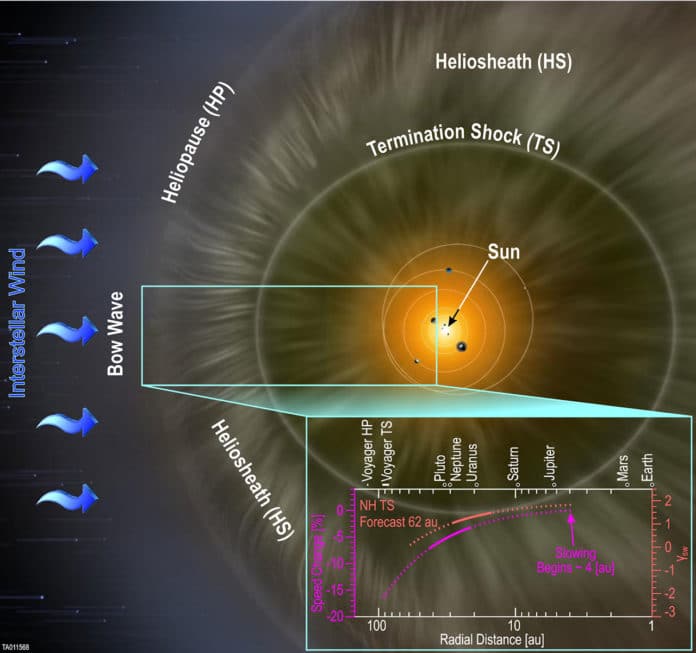The solar wind is a stream of energized, charged particles, primarily electrons, and protons, flowing outward from the Sun, through the solar system. Made of plasma, the solar wind flows at speeds as high as 900 km/s and a temperature of 1 million degrees (Celsius).
A new study provides a deeper understanding of how the solar wind evolves at increasing distances from the Sun.
Until now, four spacecraft- Pioneer 10 and 11 and Voyager 1 and Voyager 2– have explored the outer solar system and outer heliosphere. These spacecraft, in addition to NASA’s New Horizons probe, are the only spacecraft ever launched that are capable of reaching interstellar space. NASA’s New Horizons craft is continuing exploring through the interstellar medium with more modern scientific instruments.
Dr. Heather Elliott, a staff scientist at SwRI, Deputy Principal Investigator of the SWAP instrument and lead author of the paper said, “Measurements are taken by the Solar Wind Around Pluto (SWAP) instrument aboard NASA’s New Horizons spacecraft are providing important new insights from some of the farthest reaches of space ever explored. Our Sun’s influence on the space environment extends well beyond the outer planets, and SWAP is showing us new aspects of how that environment changes with distance.”
From abroad board New Horizons, SWAP gathers precise, daily estimations of the solar wind just as other key parts called “interstellar pickup ions” in the external heliosphere. These interstellar pickup ions are made when neutral material from interstellar space enters the solar system and gets ionized by light from the Sun or by charge exchange interactions with solar wind ions.
The SWAP team compared the New Horizons solar wind speed measurements from 21 to 42 astronomical units to the speeds at 1 AU from both the Advanced Composition Explorer (ACE) and Solar TErrestrial RElations Observatory (STEREO) spacecraft. (One AU is equal to the distance between the Sun and Earth.) By 21 AU, it appeared that SWAP could be detecting the slowing of the solar wind in response to picking up interstellar material. However, when New Horizons traveled beyond Pluto, between 33 and 42 AU, the solar wind measured 6-7% slower than at the 1 AU distance, confirming the effect.
As solar wind slows down at farther distances, its temperature and density also change. This change could also provide a means to estimate when New Horizons will join the Voyager spacecraft on the other side of the termination shock, the boundary marking where the solar wind slows to less than the sound speed as it approaches the interstellar medium.
Based on current lower levels of solar activity and lower solar wind pressures, the termination shock is expected to have moved closer to the Sun since the Voyager crossings. Extrapolating current trends in the New Horizons measurements also indicates that the termination shock might now be closer than when Voyager intersected it.
At the earliest, New Horizons will reach the termination shock in the mid-2020s. As the solar cycle activity increases, the increase in pressure will likely expand the heliosphere. This could push the termination shock to the 84-94 AU range found by the Voyager spacecraft before New Horizons has time to reach the termination shock.
While estimating the solar wind, New Horizons’ SWAP is amazingly sensitive and at the same time, gauges the low fluxes of interstellar pickup ions with unprecedented time resolution and extensive spatial coverage.
New Horizons Principal Investigator Dr. Alan Stern of the SwRI said, “New Horizons has significantly advanced our knowledge of distant planetary objects, and it’s only fitting that it is now also revealing new knowledge about our own Sun and its heliosphere.”
The paper “Slowing of the Solar Wind in the Outer Heliosphere” by Elliott, D.J. McComas, E.J. Zirnstein, B.M. Randol, P.A. Delamere, G. Livadiotis, F. Bagenal, N.P. Barnes, S.A. Stern, L.A. Young, C.B. Olkin, J. Spencer, H.A. Weaver, K. Ennico, G.R. Gladstone, and C.W. Smith, was published November 11 in The Astrophysical Journal.
